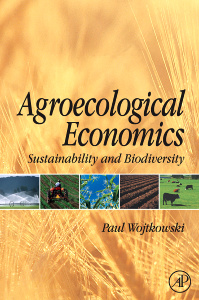Description
Agroecological Economics
Sustainability and Biodiversity
Author: Wojtkowski Paul
Language: English
Subjects for Agroecological Economics:
Keywords
resource; vector; biodiversity; intercropping; agroforestry; rotation; ex-farm input
Approximative price 77.27 €
Subject to availability at the publisher.
Add to cart300 p. · 15.2x22.8 cm · Paperback
Description
/li>Contents
/li>Readership
/li>Biography
/li>Comment
/li>
As the environmental movement unfolds, the importance of biodiversity and long-term sustainability are indisputable. Progress depends on determining the economic viability of terrestrial agroecosystems. What is lacking is the analysis needed to bring biodiverse and sustainable systems to fruition. Agroecological Economics analyzes the current topics that must be addressed in order to provide sustainable agricultural systems. It explains the economics of land-use ecology with emphasis on changing over from a conventional model of agriculture to environmentally- and ecologically-friendly models and the financial incentives that are important to these practices.
* Analyzes agricultural solutions with economic testing
* Includes a complete analysis of recent biodiversity-based research with valuable new economic methodologies
* Provides various applications to mitigate the problems which have economic and ecological effects on agroecosystems
* Offers applications of ecologically-sound land-use practices in production and manufacturing
Chapter 1 - Introduction
Ecology and agroecology
Traditional subdivisions
Agroecological directions
The philosophical dilemma
Economic directions
The economic options
Measurement
Intangibles
Intuitiveness
Chapter 2 ? Lead-up Agrobiomonics
Essential resources
The limiting resource
Nutrient profiles
Agroecological niches
Governance
Plant-plant
Ecosystem
Analytical ratios
Output
Costs
Risk
Chapter 3 - Vector Theory
Vectors
The base
Agroecological vectors
Genetic improvement
Varietal
Microbial
Agrobiodiversity
Biodiversity (facilitative associations) Rotational
Cross or inter-plot
Location
Physical land modifications
Ex-farm inputs
Environmental setting
Allying vectors
Design
Design variables
Agrotechnologies
Principal mode
Auxiliary
Add-ons
Objectives
Optimization
Chapter 4 - Agrobiodiversity
Applications
Underlying biodynamics
Yield gains
Interception
Conversion
Cost reductions
Risk abatement
Climate
Insect and plant diseases
Relevant guidelines
Economic measures
Revenue-enhanced LER
Production possibilities curve
Ratio lines
The PPC
Design variables
Species
Planting density
Spatial pattern
Temporal adjustments
Density, diversity, disarray, duration
The non-harvest option
Associated agrotechnologies
Monocultural
Pure
Varietal/ genus
Productive intercropping
Simple mixes
Strip cropping(seasonal)
Barrier or boundary
Complex agroecosystems (without trees)
Productive agroforestry
Isolated tree
Alley cropping (treerow)
Strip cropping(mixed tree)
Agroforestry intercropping
Shade systems (light)
Agroforests
Chapter 5 - Biodiversity
Applications
Underlying biodynamics
Yields
Cost reductions
Substitutable inputs
DPCs
Cut-and-carry
Risk abatement
Rain impact
Climate
Insects and diseases
Relevant guidelines
Economic measures
CER
LER and RVT-adjusted CER
Illustrated
Adjusted CER curves
Economic orientation ratio
Design variables
Specific interaction zones
Spatial Patterns
Timing
Pruning
Associated agrotechnologies
Perceived monocultures
Facilitative intercropping
Simple mixes
Strip cropping
Boundary
Covercrops
Facilitative agroforestry
Parkland
Protective barrier
Alley cropping (hedgerow)
Strip cropping (woody)
Crop over tree
Physical support systems
Shade systems (heavy)
Chapter 6 ? Rotations
Applications
Underlying biodynamics
Yield gains
Temporal DPCs
Fallows
Cost reductions
Risk abatement
Climate
Insects and diseases
Relevant guidelines
Economic measures
Sustainability
Ordering
Design variables
Delayed sowing
Planting
Associated agrotechnolgies
Single rotations
Series rotations
Overlapping cycles
Taungyas
Simple
Extended
Multi-stage
End stage
Continual
Chapter 7 ? Genetic, Varietal and Locational
Applications
Underlying Biodynamics
Varietal selection
Locational selection
Relevant guidelines
Economic measures
Design Variables
Micro-location
Macro-location
Associated agrotechnologies
Elevation
Scattering
Chapter 8 ? Land Modifications
Applications
Underlying Biodynamics
Water dynamics
Runoff
Drought
Flooding
Temperatures
Relevant guidelines
Economic measures
Design variables
Associated agrotechnologies
Absorption zones/ micro-catchments
Infiltration contours
Terraces
Stone
Earthen
Progressive
Paddies
Ponds
Gabons
Waterbreaks
Cajetes
Water channels
Mounds and beds
Stone clusters
Chapter 9 - Cross-Plot Influences
Applications
Underlying biodynamics
Yield gains
Agroecosystem properties
Interface and spillover theory
Cost control
Relevant guidelines
Economic measures
Design variables
Interfaces
Buffer species
Associated agrotechnologies
Windbreaks
Anti-insect barriers
Habitats/ corridors
Riparian buffers
Firebreaks
Living fences
Chapter 10 ? Ex-farm Inputs
Applications
Underlying biodynamics
Yield gains
Cost reductions
Weed control
Risk abatement
Climate
Insects and diseases
Economic measures
Marginal Gains
Substitutions
Truant inputs
Design variables
Nutrients
Spot applications (row placement)
Timing
Insects
Irrigation
Flood
Spray
Drip
Associated agrotechnologies
Chapter 11 - Microbial and Environmental Setting
Applications
Underlying biodynamics
Yield gains
Cost reductions
Risk abatement
Water dynamics
Insects and plant diseases
Temperatures
Relevant guidelines
Economic measures
Design variables
Associated agrotechnologies
Composting
Tillage
Traps
Bird and bats
Chapter 12 - Single-Plot Design
DAPs
Task ordering or layering
Essential nutrients
Water
Insects
Weeds
Temperatures
Erosion
Multi-tasking
Design economics
Principal-mode agrotechnologies
Ratios
Guidelines
Add-ons
Cross-harmony
Economic orientation
Input efficiency
Post-design screening
Cultural
Environment
Profit and loss
Chapter 13 - Multi-Plot Analysis
Inter-plot coordination
Revenue and cost orientation
Pitfalls
Economic measures
LLER
LEOR
Risk
Environmental objectives
Indices
Mimicry
Aesthetic objectives
Cultural agroecology
Farm landscape patterns
Blocks
Strips
Groups
Pivot
Circular
Scattered
Chapter 14 - Agrotechnological Expansions
Feed systems
Silvopastoral
Pastures
Pastures with trees
Forage trees with pasture
Forage trees alone
Aqua-agriculture
Entomo-agriculture
Avian-agriculture
Semi-husbandry
Support systems
Seasonal support
Perennial support
Vine over tree
Tree over vine
Vine within a canopy
Supplementary vine additions
Root support systems
Riparian Buffers
Complex agroecosystems
Natural compatibility
Variations
Homegardens
Shrub gardens
Forest gardens
Management
Economics
Case studies
The green revolution
Medieval agriculture
Hillside maize
A vector search
Chapter 15 - Analytical Refinements
LER variations
Row-based
Temporal
Event-enumerated
Continuums
The PPC
Essential resource economics
Resource hypotheses
The counter view
Spatial patterns
Spatial theory
Disarray
Patterned disarray
Temporal economics
Multi-participant agroecosystems
Intuitive and intangible
Diagnosis
Bioeconomic modeling
Chapter 16 ? Summary
The paradigm
Vectors
The agrotechnologies
Outcomes vs. agrotechnologies
Policy
Agroecological economics
Conclusion
Author Index
References
Having observed agriculture in six continents and over 70 countries, Dr. Wojtkowski has seen what works and what doesn't. As a trained economist with advanced degrees in both agricultural and forest economics, he is able to take the next step; that of presenting agroecology as a fully-fledged science complete with its own economic underpinnings.
* Includes a complete analysis of recent biodiversity-based research with valuable new economic methodologies
* Provides various applications to mitigate the problems which have economic and ecological effects on agroecosystems
* Offers applications of ecologically-sound land-use practices in production and manufacturing




